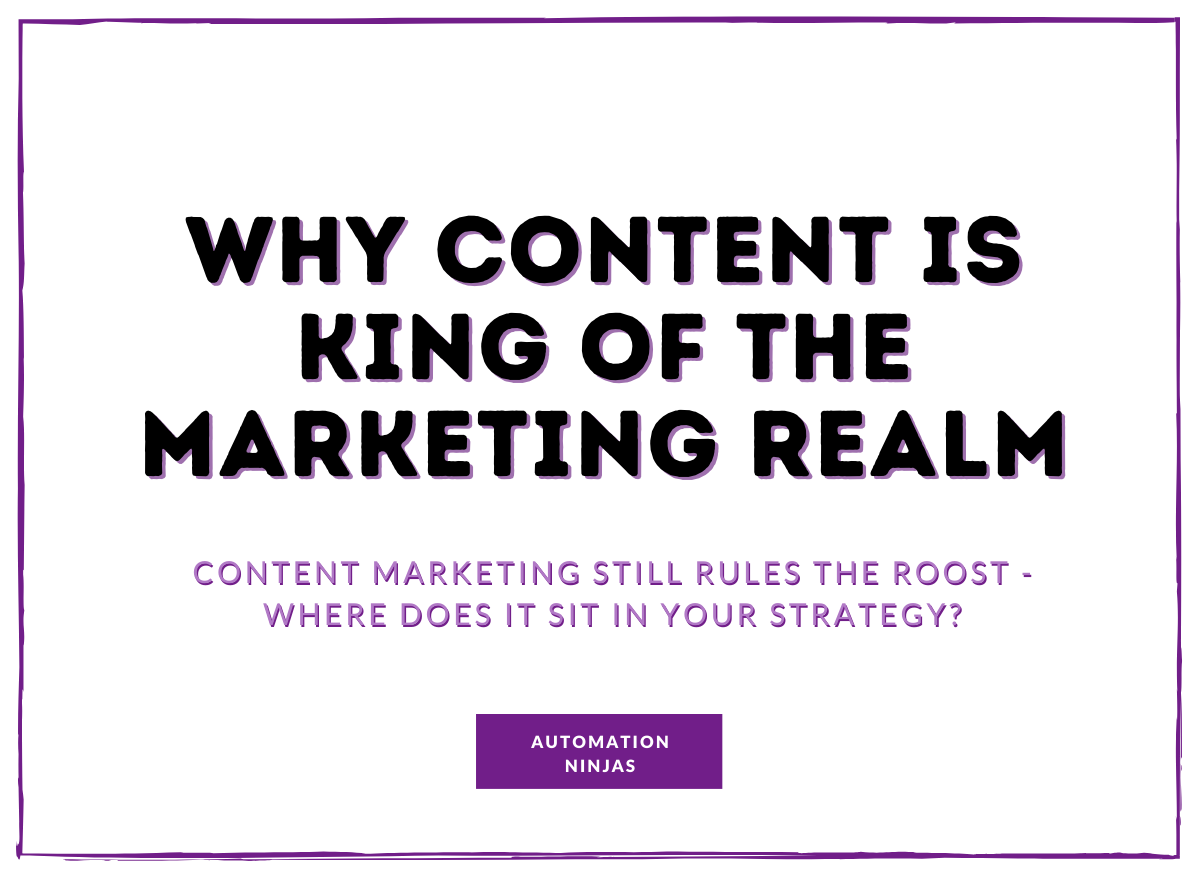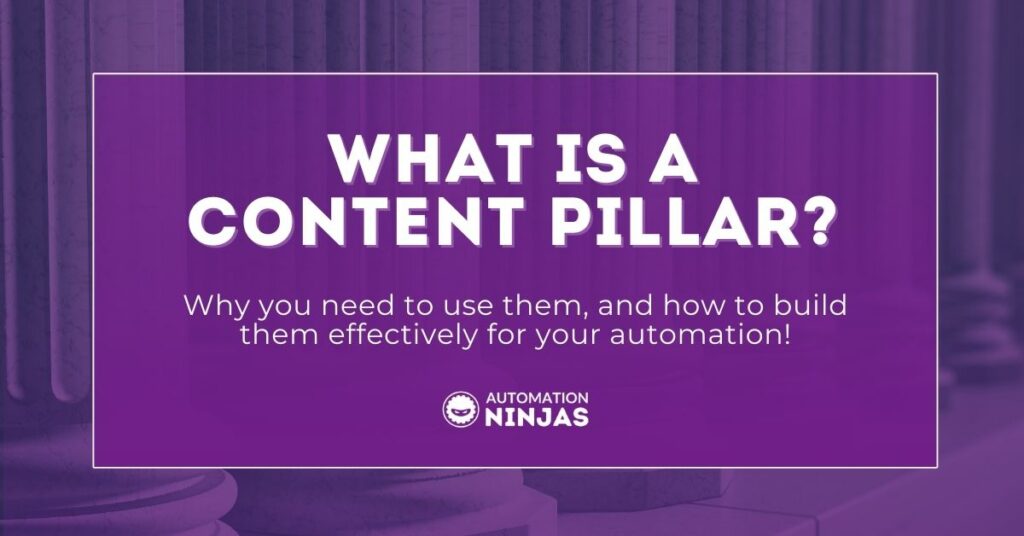If you’re not used to writing content, it can feel like a bit of a thorn in your side. Especially if writing isn’t something that comes naturally to you. However, content is king and will forever hold the throne. So, if you’re a business owner or marketer, you have to get on board and allow that content ball to keep on rolling.
You will however, be very happy to hear that writing content can be easier than you ever thought. The answer to your problems? Content pillars!
Content pillars are incredibly helpful when it comes to content creation as they help you to create clear, defined categories that aid you when coming up with ideas for your content. And, content pillars also assist you in creating a defined brand identity that your consumers can resonate with.
Today, we are talking about all things content pillar! In this blog, we’re going to dive into:
What a content pillar is
Why you should be using content pillars
How to build your own content pillars
Let’s jump in!
What is a content pillar?
To begin, let’s first give a clear definition of what a content pillar is.
Content pillars (also known as content buckets) are themes or subjects that your brand can use to develop content. Think of these as different categories that you can separate your content into.
These themes are specific to your brand and should align with the content that is the most well-liked by your digital audience.
Having an understanding of the content that your audience likes to consume is vital before you begin building your content pillars. Each business is unique and will have it’s own USP. As businesses and selling points vary, so will your consumers and the content that they would like to receive.
If you want to know more about how you gain an understanding of the content that your consumers want to see, we’ll explore that later on in the ‘How to build your own content pillars’ section.
To give you an example of what your content pillars could look like, take a look at some of our content pillars that we have put into our scheduling system.

Because we know what kind of content our clients like to see, we have been able to create pillars that help us create and categorise our content.
Let’s say that you are an e-commerce fashion retailer. It’s probably highly unlikely that you would have pillars that are identical to ours. You may swap ‘this pleases us’ for something about the top fashion trends at the moment. Or, instead of marketing teardowns, you may opt for a critique of the looks that were showcased at a recent award show.
Why you should be using content pillars
Now that you know what a content pillar is, it’s time to explore why you should be using content pillars. There are a few reasons for this and they’re each as important as the other:
Content is king!
In the digital world that we find ourselves, it’s no surprise that content will have a huge impact on business.
Content is one of the most effective ways to turn viewers into leads. Companies that produce blog content are attracting 67% more leads than those that don’t. And, 82% of all customers have a more positive outlook on a company/business after reading custom content.
Content marketing allows you to do more than just obtain more leads and sales. Content allows you to add value to the lives of your prospects and customers. Value can come in many forms. A laugh from a meme or new knowledge from an educational post is just as valuable as your latest post about your upcoming sale.
Value allows your customers to build a steadfast relationship with you and your brand. Which is exactly what you want to increase your CLV and to build a community of loyal, lifelong customers that come back to you time and time again.
There is a lot more to why content has the crown and if you’re interested, our content ninja extraordinaire Ashton has written a blog all about it that you can find here.Content pillars help to categorise and diversify your content
It’s not enough to just write content and hope that is what your leads and customers are looking for. Content pillars encourage you to split your content into categories.
This is a very basic and broad example as the pillars that you create should be more in-depth to really tap into the needs of your audience. (Similar to the example I gave you earlier about the content pillars that we have in place). But, let’s say that these are the five pillars that you create: Promotional, educational, community, entertainment and engagement.
Now that you have built these pillars, you are able to make sure that you are creating content that is diverse enough to put in each pillar. It also allows you to make sure that you are adding value to the content that you are creating and sending out to your audience.
You’ll notice that there is only one promotional pillar. This again shows you that your focus should be on adding value to your audience. The content that fills the other pillars will allow them to move through their awareness journey, all the way through to the point of sale.Content pillars = strong brand identity
It is absolutely essential for any brand that there is consistency within the content and messaging that you send out to your audience. In the same way that you have a persona in your mind for your consumers, they will have one of you, too. This persona or identity is directly built upon the way that you choose to market your products and services.
You want your content to be easily recognizable. Working within the content pillars that you build for yourself helps you to build a strong brand identity that your consumers know and love.

Content pillars give you insight
If you’re keeping track of how well your content is performing, (which you should be!) you will be able to see which types of content your audience engage with the most.
If you’re noticing that your leads and customers don’t engage with the content that lives within a particular pillar, you know that this is the time to switch it up. On the flip side, content pillars will help you recognise what you’re doing well so that you can do more of it.
Ultimately, the pillars will help you to gain a deeper understanding of the likes and dislikes of your consumers. Remember, knowledge is power. And, there is nothing more powerful than sending out high quality, personalised content!
How to build content pillars for your business
So, now you know what content pillars are and why you should be utilising them to create your content, it’s time to tell you how you can go about building content pillars that work for you!
Look at your target audience
If you want your content to hit the nail on the head, you need to know who it is that you’re talking to. The content that will resonate with the audience for a marketing automation company would be wildly different to the content that would suit the audience of a company that sells hair care products.
In order to create content pillars that are effective, you need to have a very clear idea of who they are. What do they like? How about dislike? What kind of things will they engage with?
(It may help you to build out your perfect customer in order to answer these questions. Looking into how to build buyer personas may help you here! Hubspot have a great blog here that includes a template to get you started)
As you’re building this persona for your audience, ask yourselves these questions to help you along the way:
Who is my target audience?
Which topics are my target audience interested in?
What is important to my target audience? What are their values and beliefs?
Which topics are valuable to my audience?
Which topics would my audience like to be educated on?
How can I use my content to hone in on my audience’s pain points?

Carry out some competitor research
Unless you have a very very veeeery niche brand, you’re going to have competitors. In order to keep your eye on the prize, you also have to keep an eye on your competitors.
Take a look at businesses that are similar to yours and take note of the content that they are creating. Make a list of 5-10 direct competitors, and head over to their social media platforms and websites to start taking notes.
What are their audience engaging with well? What are their least popular pieces of content? Use this information to identify any gaps within their content and use that information to your advantage when you’re building your pillars.
Remember that competitor research isn’t about copying your competitors or stealing their ideas. It’s great to take inspiration but your audience will be looking for authenticity. The information you obtain from your research should make a great breeding ground for your own creativity and ideas!
Time to audit!
Content audits are needed and absolutely necessary for any business that uses content in their marketing strategy. The answers that you’re looking for to help build your content pillars are in the data, you just need to find it!
Take a look at all of the content that you have posted over the past year across various social media channels. Then, look at the engagement on each.
You will be able to clearly see the content that your audience likes and dislikes. Whether that be through the amount of link clicks, time on the page, comments and likes - there is more than enough there to help you with building your content pillars.
If you used UTM parameters and have used UTM links within your content, you will have even more juicy data to use! If you’re not using UTM parameters at the moment, this is the perfect time to employ that into your strategy. That way, the next time you complete a content audit, you will have more data that will help you better understand your audience.
Ready to build those content pillars?
As the digital world develops, content will only become more important than it already is. With your new found knowledge surrounding content pillars, you get to make sure that you’re ahead of the game.
Once you’ve fleshed out your content pillars, all that is left is the fun part - creating content!
We’ve spoken a little bit about how important it is to make sure that the content you create is valuable to your audience, if you need a hand with that, we have a blog here that will be exactly what you need.
Or, if you think that your content and strategy could do with a little more TLC than you can manage alone, we’re always ready and waiting to give you a helping hand.
Right, that’s enough from me. Go build those pillars!





